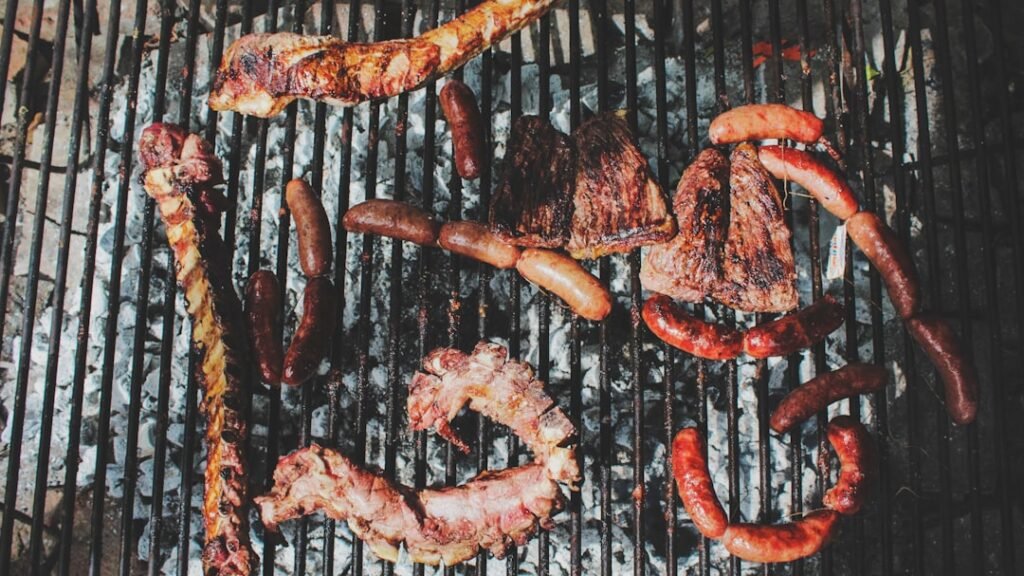Low and Slow: Mastering BBQ Cooking Techniques

Low and slow cooking is a culinary technique that has gained immense popularity among barbecue enthusiasts and home cooks alike. This method involves cooking food at low temperatures for extended periods, allowing flavors to develop and meats to become tender. The beauty of low and slow cooking lies in its simplicity; it requires minimal intervention once the cooking process begins.
I find that this approach not only enhances the taste of the food but also creates an inviting atmosphere, as the aroma of slowly cooked meats wafts through the air, enticing everyone around. The science behind low and slow cooking is fascinating. When meat is cooked at lower temperatures, the collagen within the muscle fibers breaks down gradually, transforming tough cuts into succulent, melt-in-your-mouth delights.
This process can take several hours, depending on the type of meat and its size. I often find myself planning my meals around this technique, as it allows me to engage in other activities while my food cooks to perfection. The patience required for low and slow cooking is rewarded with rich flavors and textures that are hard to replicate with faster cooking methods.
Choosing the Right Cuts of Meat
Selecting the right cuts of meat is crucial for achieving the best results in low and slow cooking. Not all meats are created equal, and some cuts are better suited for this method than others. I have learned that tougher cuts, such as brisket, pork shoulder, and ribs, are ideal candidates for low and slow cooking.
These cuts contain more connective tissue and fat, which break down during the long cooking process, resulting in tender and flavorful dishes. When I choose my cuts, I often look for marbling—those little flecks of fat within the muscle—which can enhance flavor and moisture during cooking. In addition to considering the cut of meat, I also pay attention to its quality.
Sourcing high-quality meat from local farms or trusted butchers can make a significant difference in the final outcome. I prefer to choose grass-fed or pasture-raised options whenever possible, as they tend to have better flavor profiles and are often more humane. By investing time in selecting the right cuts, I set myself up for success in my low and slow cooking endeavors.
Mastering Temperature Control

Temperature control is one of the most critical aspects of low and slow cooking. Maintaining a consistent temperature throughout the cooking process ensures that the meat cooks evenly and thoroughly. I have found that using a reliable thermometer is essential for monitoring the internal temperature of the meat as well as the ambient temperature of my cooking environment.
Whether I’m using a smoker or a grill, I always keep an eye on these readings to avoid any drastic fluctuations that could compromise my dish. I also appreciate the importance of patience when it comes to temperature control. Low and slow cooking is not a race; it’s about allowing time for flavors to meld and textures to develop.
I often set my smoker or grill to a temperature between 225°F and 250°F, which is ideal for most cuts of meat. By resisting the urge to crank up the heat for quicker results, I ensure that my meals turn out tender and juicy every time.
Selecting the Best Wood for Smoking
| Wood Type | Flavor Profile | Best Used with |
|---|---|---|
| Apple | Mild, fruity | Poultry, pork, game birds |
| Hickory | Strong, smoky | Beef, pork, game meats |
| Mesquite | Strong, earthy | Beef, lamb, game meats |
| Cherry | Sweet, fruity | Poultry, pork, game birds |
The choice of wood for smoking can significantly impact the flavor profile of my low and slow cooked meats. Different types of wood impart distinct flavors, and I enjoy experimenting with various options to find the perfect match for each dish. For instance, hickory is known for its strong, bold flavor, making it an excellent choice for beef and pork.
On the other hand, fruitwoods like apple or cherry provide a milder sweetness that pairs beautifully with poultry and fish. When selecting wood for smoking, I also consider whether to use chunks, chips, or pellets. Each form has its advantages; chunks burn longer and provide a steady smoke, while chips ignite quickly and are great for shorter cooks.
I often find myself mixing different types of wood to create unique flavor combinations that elevate my dishes to new heights. The process of choosing wood becomes an integral part of my cooking journey, allowing me to express my creativity while enhancing the overall experience.
Enhancing Flavor with Dry Rubs and Marinades
To elevate my low and slow cooked meats further, I turn to dry rubs and marinades. These flavor enhancers can transform a simple cut of meat into a culinary masterpiece. I enjoy experimenting with various spice blends, often incorporating ingredients like paprika, garlic powder, brown sugar, and cayenne pepper to create a balanced rub that complements the natural flavors of the meat.
Applying a dry rub several hours before cooking allows the spices to penetrate the meat, resulting in a more flavorful final product. Marinades are another fantastic way to infuse flavor into my dishes. I often create marinades using acidic components like vinegar or citrus juice combined with herbs and spices.
The acid helps tenderize the meat while imparting delicious flavors. I typically marinate tougher cuts overnight, allowing ample time for the flavors to meld together. The combination of dry rubs and marinades not only enhances taste but also adds an appealing crust or bark during the cooking process.
Monitoring and Maintaining Smoke Levels

Monitoring smoke levels is essential for achieving that coveted smoky flavor in my low and slow cooked meats. Too much smoke can lead to bitterness, while too little can result in a lackluster taste. I have learned that maintaining a thin blue smoke is ideal; it indicates that my wood is burning cleanly without producing excessive creosote.
To achieve this balance, I often experiment with different types of wood and adjust airflow in my smoker or grill. I also pay attention to how often I add wood during the cooking process. While it’s tempting to keep adding more wood for a stronger smoke flavor, I’ve found that moderation is key.
Typically, I add wood chunks every hour or so, depending on how long my cook will last. This approach allows me to maintain consistent smoke levels without overwhelming the meat’s natural flavors.
Perfecting the Art of Barbecue Sauce
Barbecue sauce is often considered the finishing touch on any low and slow cooked meal. Crafting my own sauce has become a delightful part of my cooking routine, allowing me to tailor flavors to suit my preferences. I enjoy experimenting with various ingredients such as tomatoes, vinegar, mustard, honey, and spices to create a sauce that perfectly complements my smoked meats.
The balance between sweetness, acidity, and spice is crucial; I often taste as I go to ensure that each element harmonizes beautifully. In addition to creating my own sauces, I also appreciate regional variations in barbecue sauce styles. From tangy Kansas City-style sauces to vinegar-based Carolina sauces, each offers a unique twist on traditional flavors.
When serving my low and slow cooked meats, I often provide a selection of sauces so that guests can customize their experience according to their tastes.
Tips for Achieving Tender and Juicy Results
Achieving tender and juicy results in low and slow cooking requires attention to detail at every stage of the process. One of my favorite tips is to let the meat rest after cooking before slicing into it. Resting allows juices to redistribute throughout the meat, ensuring that each bite is moist and flavorful.
I typically cover the meat loosely with foil during this resting period to keep it warm while preventing it from steaming. Another essential tip is to avoid overcooking the meat. While low and slow cooking requires patience, it’s crucial not to let it go too far beyond its target internal temperature.
Using a reliable thermometer helps me monitor doneness accurately; for example, brisket is typically perfect at around 195°F to 205°F when it becomes tender enough to pull apart easily. By following these tips and embracing the art of low and slow cooking, I consistently achieve mouthwatering results that leave everyone craving more. In conclusion, low and slow cooking is an art form that combines patience, technique, and creativity.
From understanding the fundamentals of this method to mastering temperature control and flavor enhancement techniques, each step contributes to creating unforgettable meals. As I continue to explore this culinary journey, I find joy in sharing my knowledge with others while savoring every delicious bite along the way.





